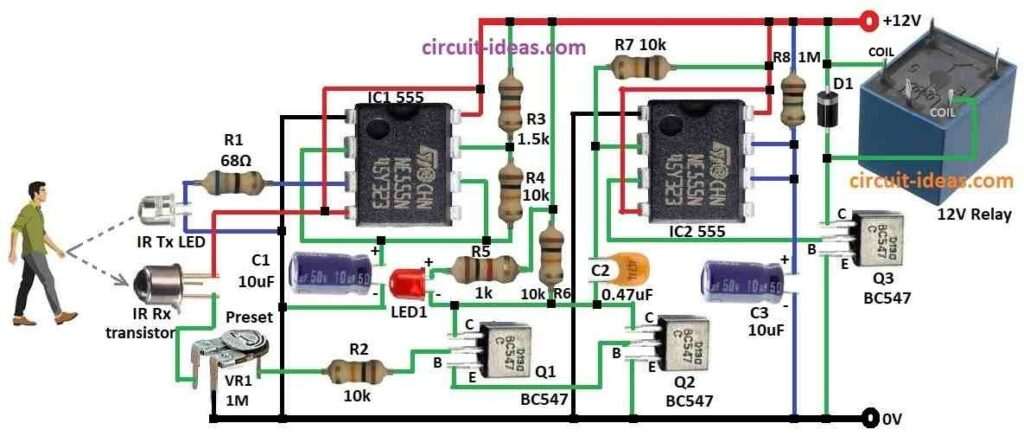This easy Motion Detector Circuit uses IC 555 to find human from far.
Circuit have two parts:
Transmitter:
IC 555 work like astable multivibrator and it make square wave signal.
This signal goes out through IR sensor (infrared).
Receiver:
Phototransistor see IR beam.
If someone moves and block the beam then phototransistor work and turn ON IC 555.
Then output device turns ON like LED or alarm.
This circuit need parts like IC 555, resistors, capacitors, IR sensor, phototransistor, LED or relay.
Circuit Working:

Parts List:
| Component Type | Description | Quantity |
|---|---|---|
| Resistors | 68Ω 1/4 watt | 1 |
| 1.5k 1/4 watt | 1 | |
| 1M 1/4 watt | 1 | |
| 1k 1/4 watt | 1 | |
| 10k 1/4 watt | 4 | |
| Preset 1M | 1 | |
| Capacitors | Ceramic 0.47μF | 1 |
| Electrolytic 10μF 50V | 2 | |
| Semiconductors | IC 555 | 2 |
| Transistors BC547 | 3 | |
| Diode D1 1N4007 | 1 | |
| LED any 5mm 20mA | 1 | |
| IR Transmitter Photodiode | 1 | |
| IR Receiver Phototransistor | 1 | |
| 12V Relay | 1 |
Infrared proximity detector is useful part in many automation systems.
We see it in auto water taps, hand dryers and some auto doors.
This circuit use 555 IC to make short high voltage pulses.
Pulses goes out as IR beams from LED.
IR beams focus on target area.
If object come in front then beam reflect back.
Phototransistor catch this reflected beam.
Then it turn ON relay and alarm.
Relay stay ON for set time which are based on circuit parts.
To test move hand near within 1 meter of IR beam.
Relay will turn ON and stay ON for some time which is set by 10uF capacitor and 1M resistor.
This shows circuit is working.
We can use 1M preset to change how sensitive it is, which means how close object must be to start alarm.
Formula:
Important formula for frequency (f) in transmitter part of 555 motion detector:
f = 1.44 / (R3 + 2×R4) × C
where,
- R3, R4 and C1 connect with IC1 555 which work as astable multivibrator.
We can change motion detection sensitivity by changing IR pulse frequency.
Use this formula to adjust frequency.
How to Build:
To build a Motion Detector Circuit using IC 555 follow below mentioned steps:
- Collect all parts shown in diagram.
- Connect pin 1 of IC1 555 to ground.
- Connect pin 2 to pin 6 of IC1.
- Connect capacitor C1 from pin 2 and 6 to ground.
- Connect pin 3 of IC1 to IR transmitter photodiode and then to ground through resistor R1.
- Connect pin 4 and pin 8 of IC1 to +12V supply.
- From +12V connect IR receiver phototransistor to first leg of preset VR1 in series.
- Connect resistor R4 between pin 6 and pin 7 of IC1.
- Connect resistor R3 from pin 7 of IC1 to +12V.
- Connect pin 1 of IC2 555 to ground.
- Connect pin 2 to pin 6 of IC2.
- Connect resistor R7 from pin 2 to +12V.
- Connect pin 3 of IC2 to base of transistor Q3.
- Connect pin 4 and pin 8 of IC2 to +12V.
- Connect pin 6 to pin 7 of IC2.
- Connect capacitor C3 from pin 6 and 7 to ground.
- Connect resistor R8 from pin 7 to +12V.
- Connect LED and resistor R5 in series from +12V to collector of Q1.
- Connect collector of Q1 to collector of Q2.
- Connect base of Q1 to first leg of preset VR1 through resistor R2.
- Connect emitter of Q1 to ground.
- Connect base of Q2 to emitter of Q1.
- Connect emitter of Q2 to ground.
- Connect collector of Q3 to +12V through diode D1.
- Connect base of Q3 to pin 3 of IC2 and emitter of Q3 to ground.
- Connect relay coil between +12V and diode D1 and second relay coil leg between D1 and Q3 collector.
Conclusion:
This Motion Detector Circuit using IC 555 is easy and works well.
It sends IR pulses detects reflected light with phototransistor and turns ON alarm or relay when motion happens.
It is useful in auto systems like security, taps and dispensers.
Leave a Reply